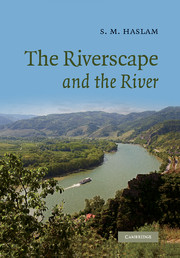Book contents
- Frontmatter
- Contents
- List of tables
- Preface
- Acknowledgements
- 1 Introduction
- 2 The natural river and its destruction
- 3 The natural riverscape and its modification
- 4 Resources I. Water resources and their loss
- 5 Development and variation of rivers
- 6 Development and variation of riverscapes
- 7 Building blocks of river vegetation
- 8 Building blocks of flood plain vegetation
- 9 Resources II. Plants and animals, cleaning and minerals
- 10 Building blocks of the riverscape
- 11 Patterns, boundaries and fragmentation
- 12 Resources III. Settlements and constructions
- 13 The harsh riverscape
- 14 The tempered or smiling riverscape
- 15 Envoi
- Bibliography
- Index to plant and animal vernacular and taxonomic names
- General subject index
2 - The natural river and its destruction
Published online by Cambridge University Press: 10 August 2009
- Frontmatter
- Contents
- List of tables
- Preface
- Acknowledgements
- 1 Introduction
- 2 The natural river and its destruction
- 3 The natural riverscape and its modification
- 4 Resources I. Water resources and their loss
- 5 Development and variation of rivers
- 6 Development and variation of riverscapes
- 7 Building blocks of river vegetation
- 8 Building blocks of flood plain vegetation
- 9 Resources II. Plants and animals, cleaning and minerals
- 10 Building blocks of the riverscape
- 11 Patterns, boundaries and fragmentation
- 12 Resources III. Settlements and constructions
- 13 The harsh riverscape
- 14 The tempered or smiling riverscape
- 15 Envoi
- Bibliography
- Index to plant and animal vernacular and taxonomic names
- General subject index
Summary
Force not the course of the river
Eccl. 4, 26The threshold to change is lowered by impact
(Evans, 1993)The concept of naturalness
A straightforward definition of natural is ‘untouched by Man’. By this definition, no rivers on earth are now natural: even the polar caps suffer from air pollution, climate change, and more people. Human impact, however, varies from being trivial to catchments totally built over with grossly polluted near-sterile rivers.
River systems are (excluding glaciation) as old as the land on which they flow. Precipitation falls, gathers into streams through gravity. Some evaporates, while the filter of the ground surface, the characters of that surface, and the underground storage all determine the channel flow. Its base flow depends on climate, season (and, regrettably, abstraction). Added to this is short-term storm flow (Petts & Foster, 1985). Older continental land masses, earth movements and climates also influence drainage patterns and how far a river travels. Separating Britain from the continent after the last Ice Age much disrupted river patterns! Sinking Malta, some people consider, has left 20 km streams where these were once the heads of large rivers
River systems are in a constant state of change; change in erosion, in deposition, in patterns horizontally, in patterns vertically, in temperature and precipitation, and in biota.
- Type
- Chapter
- Information
- The Riverscape and the River , pp. 16 - 52Publisher: Cambridge University PressPrint publication year: 2008



